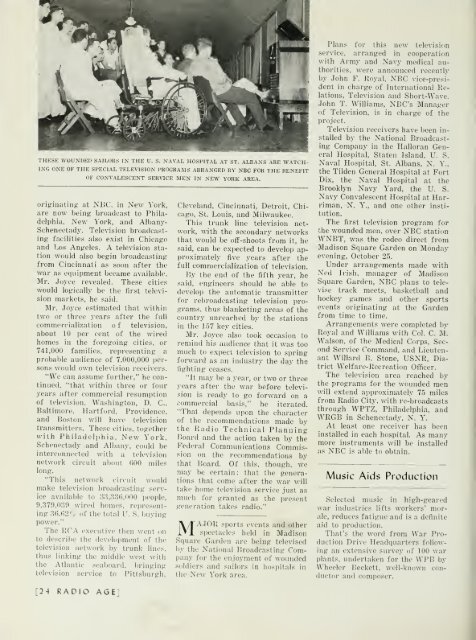Radio Age - 1944, January - 36 Pages, 3.3 MB ... - VacuumTubeEra
Radio Age - 1944, January - 36 Pages, 3.3 MB ... - VacuumTubeEra
Radio Age - 1944, January - 36 Pages, 3.3 MB ... - VacuumTubeEra
You also want an ePaper? Increase the reach of your titles
YUMPU automatically turns print PDFs into web optimized ePapers that Google loves.
THESE WOUNDED SAILORS IN THE U. S. NAVAL HOSPITAL AT ST. ALBANS ARE WATCH-<br />
ING ONE OF THE SPECIAL TKLEVISION PROGRAMS ARRANGED BY NBC FOR THE BENEFIT<br />
OF CONVALESCENT SERVICE MEN IN NEW YORK AREA.<br />
originating at NBC, in New York,<br />
are now being broadcast to Philadelphia,<br />
New York, and Albany-<br />
Schenectady. Television broadcasting<br />
facilities also e.xist in Chicago<br />
and Los Angeles. A television station<br />
would also begin broadcasting<br />
from Cincinnati as soon after the<br />
war as e(|iiipment became available.<br />
Mr. Joyce revealed. These cities<br />
would logically be the first television<br />
markets, he said.<br />
Mr. .Joyce estimated that within<br />
two or three years after the full<br />
commercialization o f television,<br />
about 10 per cent of the wired<br />
homes in the foregoing cities, or<br />
741,000 families, representing a<br />
probable audience of 7.000,000 persons<br />
would own television receivers.<br />
"We can assume further," he continued,<br />
"that within three or four<br />
years after commercial resumption<br />
of television, Washington, D. C,<br />
Baltimore, Hartford, Providence,<br />
and Boston will have television<br />
transmitters. These cities, together<br />
with Philadelphia, New York,<br />
Schenectady and Albany, could be<br />
interconnected with a television<br />
network circuit about (UK) miles<br />
long.<br />
"This network lircuit would<br />
make television broadcasting service<br />
available to 33,3<strong>36</strong>,000 people,<br />
9,379,039 wired homes, representing<br />
3().62^r of the total U. S. buying<br />
power."<br />
The RCA executive then went on<br />
to descrilie the development of the<br />
television network by trunk lines,<br />
thus linking the middle west with<br />
the Atlantic seaboard, bringing<br />
television service to Pittsburgh,<br />
[24 RADIO AGE]<br />
Cleveland, Cincinnati, Detroit, Chicago,<br />
St. Louis, and Milwaukee.<br />
This trunk line television network,<br />
with the secondary networks<br />
that would be off-shoots from it, he<br />
said, can be expected to develop approximately<br />
five years after the<br />
full commercialization of television.<br />
By the end of the fifth year, he<br />
said, engineers should be able to<br />
develop the automatic transmitter<br />
for rebroadcasting television programs,<br />
thus blanketing areas of the<br />
country unreached by the stations<br />
in the 157 key cities.<br />
Mr. .Joyce also took occasion to<br />
remind his audience that it was too<br />
much to expect television to spring<br />
forward as an industry the day the<br />
fighting ceases.<br />
"It may be a year, or two or three<br />
years after the war before television<br />
is ready to go forward on a<br />
commercial basis," he iterated.<br />
"That depends upon the character<br />
of the recommendations made by<br />
the <strong>Radio</strong> Technical Planning<br />
Board and the action taken by the<br />
Federal Communications Commission<br />
on the recommendations by<br />
that Board. Of this, though, we<br />
may be certain: that the generations<br />
that come after the war will<br />
take home television service just as<br />
much for granted as the present<br />
generation takes radio."<br />
MAJOR sports events and other<br />
spectacles held in Madison<br />
Square Garden are being televised<br />
by the National Broadcasting Company<br />
for the en.ioyment of wounded<br />
soldiers and sailors in hospitals in<br />
the New York area.<br />
Plans for this new television<br />
service, arranged in cooperation<br />
with Army and Navy medical authorities,<br />
were announced recently<br />
by John F. Royal, NBC vice-president<br />
in charge of International Relations,<br />
Television and Short-Wave.<br />
.John T. Williams, NBC's Manager<br />
of Television, is in charge of the<br />
project.<br />
Television receivers have been installed<br />
by the National Broadcasting<br />
Company in the Halloran General<br />
Hospital, Staten Island, U. S.<br />
Naval Hospital, St. Albans, N. Y.,<br />
the Tilden General Hospital at Fort<br />
Dix, the Naval Hospital at the<br />
Brooklyn Navy Yard, the U. S.<br />
Navy Convalescent Hospital at Harriman,<br />
N. Y., and one other institution.<br />
The first television program for<br />
the wounded men, over NBC station<br />
WNBT, was the rodeo direct from<br />
Madison Square Garden on Monday<br />
evening, October 25.<br />
Under arrangements made with<br />
Ned Irish, manager of Madison<br />
Square Garden, NBC plans to televise<br />
track meets, basketball and<br />
hockey games and other sports<br />
events originating at the Garden<br />
from time to time.<br />
Arrangements were completed by<br />
Royal and Williams with Col. C. M.<br />
Walson, of the Medical Corps, Second<br />
Service Command, and Lieutenant<br />
Willard B. Stone, USNR, District<br />
Welfare-Recreation Officer.<br />
The television area reached by<br />
the programs for the wounded men<br />
will extend approximately 7.5 miles<br />
from <strong>Radio</strong> City, with re-broadcasts<br />
through WPTZ, Philadelphia,<br />
WRGB in Schenectady. N. Y.<br />
and<br />
At least one receiver has been<br />
As many<br />
installed in each hospital.<br />
more instruments will be installed<br />
as NBC is able to obtain.<br />
Music Aids Production<br />
Selected music in high-geared<br />
war industries lifts workers' morale,<br />
reduces fatigue and is a definite<br />
aid to production.<br />
That's the word from War Production<br />
Drive Headquarters following<br />
an extensive survey of 100 war<br />
plants, undertaken for the WPB by<br />
Wheeler Beckett, well-known conductor<br />
and composer.
















